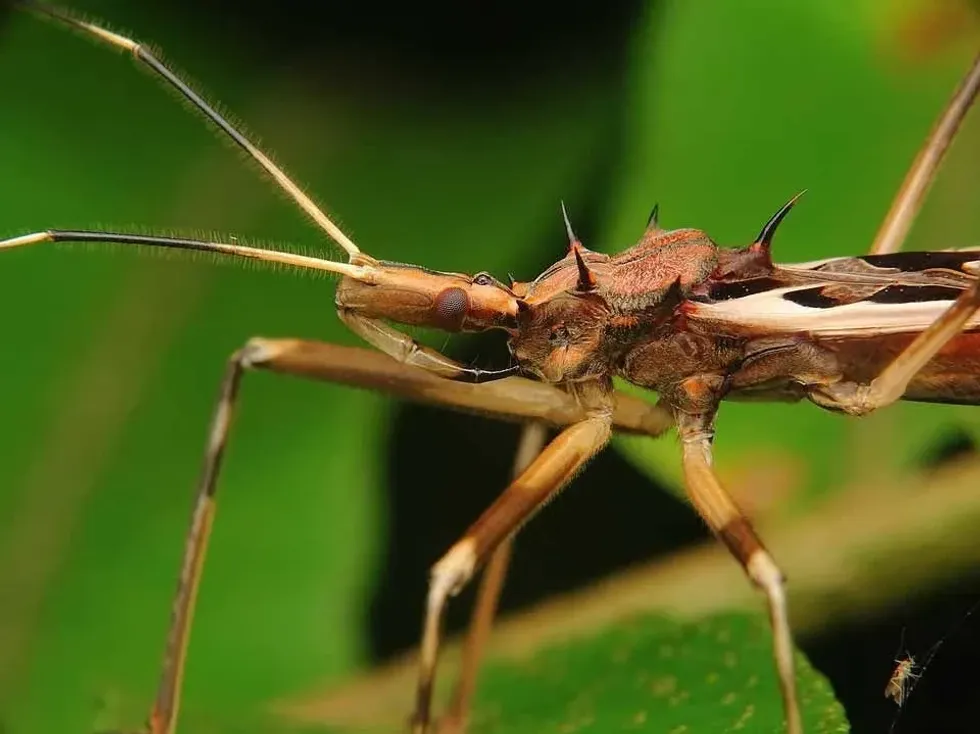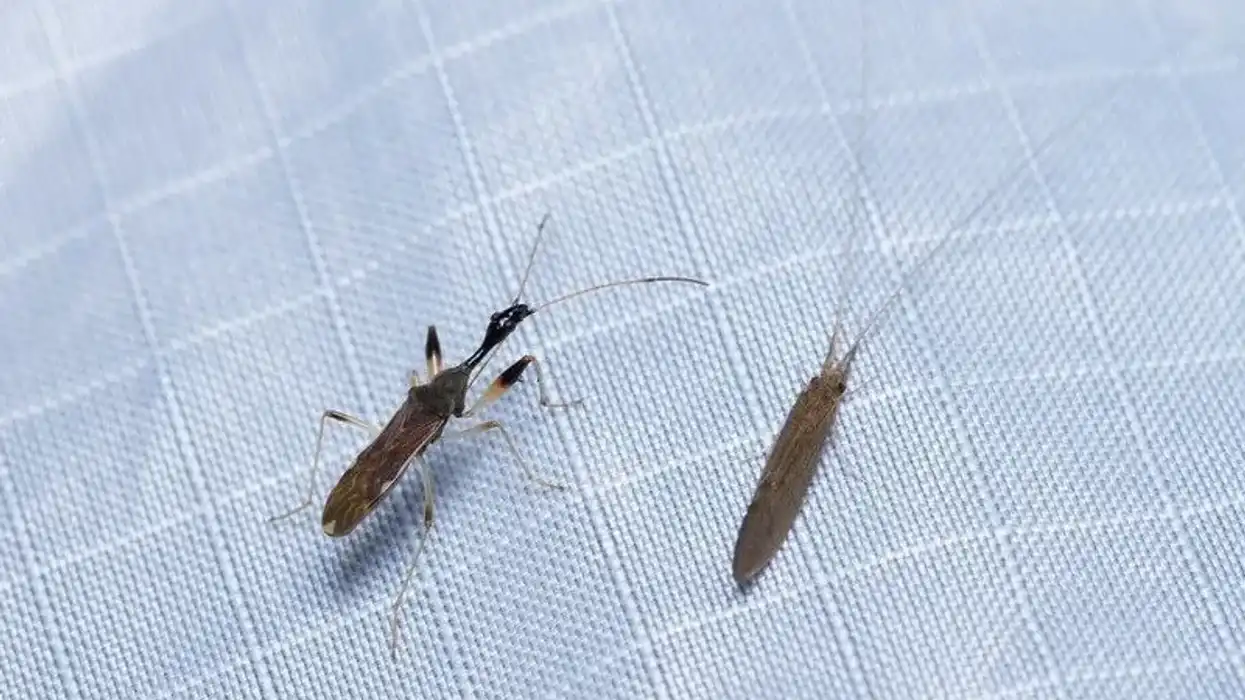Wheel bugs are the insect predators of the animal kingdom. Also known as the assassin bug, wheel bug (Arilus cristatus) prey upon other insects such as moths, caterpillars, Japanese Beetles, cabbageworm, tent caterpillars, orange dogs, and Mexican bean beetle.
Assassin bug comes under the true bug order. The reason behind their unique name is that the wheel bugs prey upon other insects. They pierce their prey using their three-segmented beak and suck all the body fluids out of the body of the prey.
Wheel bugs are quite large in size than any other ordinary insect. They appear quite unusual, thus often people think of them as aggressive species.
However, in reality, the species of wheel bugs are extremely shy and try to avoid contact as much as possible. But it is necessary to handle them carefully, to avoid wheel bug bite.
Many people are not even aware of this particular species. But people who are aware of this species, know that these assassin bugs are considered beneficial as they help to prevent pest that causes harm to plants.
Adult wheel bugs have a bright red color when they first molt, but soon the color starts to change to grey. These assassin bugs are filled with fun and interesting facts. Keep on reading to discover more.
Are you interested to read more such interesting content? Then visit yellow jacket wasp and mud dauber wasp.
Wheel Bug Interesting Facts
What type of animal is a wheel bug?
Wheel bug (Arilus cristatus) is an insect with unusual characteristics. Unlike other insects in the animal kingdom, they prey upon other insects like assassin bugs.
What class of animal does a wheel bug belong to?
Wheel Bugs belong to the Insecta class. These bugs are popular as assassin bugs because they feed on other insects. Using their three-segmented beaks they pierce the insect and suck all the body fluids from it. Thus, even though considered good for humans, the bugs indeed are not good for other fellow insects.
How many wheel bugs are there in the world?
The exact number of wheel bugs in the world is unknown. However, among the four recognized species, only Arilus cristatus gets spotted from time to time. Another reason behind their rare occurrence can be their credible skills of camouflage. These predators are actually very shy in nature.
Where does a wheel bug live?
Adult wheel bugs feed upon plant pests. Thus, these bugs are often found in trees, meadows, and shrubs. They are also considered beneficial for the plants for this reason.
What is a wheel bug's habitat?
Wheel bugs are mostly found in California, Rhode Island west, Florida, Texas, Blatchley, Mexico, Florida, and Guatemala. However, rarely spotted due to their shy nature and are also considered to be masters of camouflage. Their habitat is the trunk of trees, flowers, and other various food.
Who do wheel bugs live with?
Wheel bugs mostly live on their own.
How long does a wheel bug live?
The average life expectancy of a wheel bug is around a year.
How do they reproduce?
The wheel bug (Arilus cristatus) initiates the reproduction cycle sometime in autumn when the female lay eggs. At one time, females can lay around 40-200 eggs.
The female bugs lay eggs in the twigs and shrubs, wheel bug eggs look like barrels and can be found in a cluster. During early spring the eggs hatch, dispersing the wheel bug nymph in the surrounding trees or shrubs.
Wheel bug nymph has a color mix of red with black marking. However, as soon as they start becoming adults, their red and black color changes from brown to grey.
What is their conservation status?
Wheel bug (Arilus cristatus) is Not Listed. However, adult wheel bugs can be rarely spotted. The reason behind this can be that an adult wheel bug is very shy. Also, the wheel bug has very good camouflage that indeed helps them in hiding.
Wheel Bug Fun Facts
What do wheel bugs look like?

The wheel bug (Arilus cristatus) belonging to the Reduviidae family, is a considerably huge bug compared to other bugs in the animal kingdom. While the wheel bug nymph has a very attractive red and black color, the adult wheel bugs, however, have a more cryptic brown to grey coloration.
They also have dark brown colored antennae. And the emerging cogwheel from the thorax that gives it its name 'wheel bug'.
How cute are they?
The young nymphs may look cute some as they have a beautiful red and black color combination, however, the adult wheel bugs do not look appealing at all. They do not have such a beautiful red and black color combination as the nymphs, and can even appear as a pretty dreadful insect.
Adults can grow up to 1 - 1.5 in (2.51 - 3.81 cm).
Apart from that, they have long legs, antennae, and, of course, the stout beak that gives them their dreadful look. Thus, it will be fair to say that the wheel bugs are not really cute.
How do they communicate?
Any typical communication method distinctive to the wheel bug is unknown. Thus, it can be assumed that a wheel bug communicates in a similar way as any other bug. An insect generally uses body parts and sound to communicate.
How big is a wheel bug?
Adults can grow up to 1-1.5 in (2.51-3.81 cm) which makes a wheel bug at least four times bigger than any other regular bug.
How fast can wheel bugs move?
The speed of a wheel bug is not known.
How much does a wheel bug weigh?
There is no credible information available regarding the weight of the wheel bug.
What are their male and female names of the species?
There are no specific names for the male and female species of the bug. Thus, both male and female bug of the species is known as wheel bug.
What would you call a baby wheel bug?
The baby of a wheel bug is popularly called wheel bug nymph.
What do they eat?
Found in trees, the wheel bug is a predator. Adults feed upon other bugs such as moths, caterpillars, Japanese Beetles. This is the reason they are called assassin bugs.
Are they harmful?
The wheels bug is not necessarily harmful, in fact, they are considered beneficial as they eat plant pests. However, if not handled carefully, there is a high chance to get bitten by a wheel bug, which will eventually lead to a wheel bug bite wound.
But these bites do not have the ability to kill a human being. Considering that the wheel bug is mostly a harmless bug.
People often get scared by their weird looks, however, there is no need to kill a wheel bug if you do not want them around. Eliminating them from the surroundings will eventually drive the wheel bug away.
Would they make a good pet?
Wheel bugs are wild insects. They live on the trees, meadows, and shrubs. In no circumstances they would make a good pet. Apart from that, wheel bug bites, which can lead to permanent scars. Thus, it is not recommended to have a wheel bug as a pet.
Did you know...
People mostly tend to call all insects bug. However, this is the only species placed in the Hemiptera order that are known as true bugs. In simples words, only insects belonging to the Hemiptera order can be referred to as a bug. The wheel bug is among the largest known true bugs belonging to its specific habitat.
Despite their unappealing looks, the bug has been able to have a stable population. The main reason behind this is that these bugs are actually welcomed by many farmers and gardeners trying to save their plants from pests organically.
Why are they called wheel bugs?
The wheel bug gets its name from its very strange appearance. It has a cogwheel emerging from its thorax which gives it its unique name 'wheel bug'.
How to tell difference between stink bug and wheel bug?
Belonging to the Reduviidae family, Hemiptera order, wheel bugs are true bugs that include other species such as bed bugs, water striders, and stink bugs. Although there are quite a lot of similarities, there are also differences prevalent between the two insects.
The main difference between the two bugs, however, is the smell. Just as the name suggests, stink bug has a very significant smell.
The smell is exceptionally strong and is able to leave an impression on its predators, even humans. On the other hand, wheel bugs have a comparatively lighter smell. Whenever the wheel bugs are disturbed, they discrete a smell from its anus.
Here at Kidadl, we have carefully created lots of interesting family-friendly animal facts for everyone to discover! Learn more about some other arthropods including giant African millipede, or atlas beetle.
You can even occupy yourself at home by drawing one on our Wheel Bug coloring pages.










